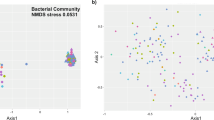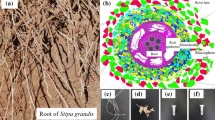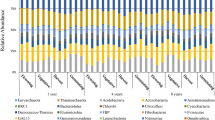Abstract
The fixation of atmospheric nitrogen by actinomycete-nodulated, woody dicotyledonous plants represents a substantial contribution to the global nitrogen cycle1, contributing especially to forested areas, wetlands, fields and disturbed sites of temperate and tropical regions2. The study of these nitrogen-fixing symbioses has been hampered by difficulties in isolating and culturing the microsymbionts in vitro. Recently, root nodule actinomycetes have been isolated by microdissection techniques and cultured in vitro3,4. We report here the isolation and culture for the first time of the actinomycetes associated with root nodules of Elaeagnus umbellata (Elaeagnaceae) and Alnus viridis ssp. crispa (Betulaceae) (shown in Fig. 1a and b, respectively), using a technique radically different from those used previously. For separating actinomycetes from root nodules, we have used the simple fractionation technique of sucrose-density sedimentation.
This is a preview of subscription content, access via your institution
Access options
Similar content being viewed by others
References
Torrey, J. G. Bioscience 28, 586–592 (1978).
Bond, G. in Symbiotic Nitrogen Fixation in Plants (ed. Nutman, P. S.) 443–474 (Cambridge University Press, 1976).
Callaham, D., Del Tredici, P. & Torrey, J. G. Science 199, 899–902 (1978).
Berry, A. & Torrey, J. G. in Symbiotic Nitrogen Fixation in the Management of Temperate Forests (ed. Gordon, J. C.) (Oregon State University Press, in the press).
Hoagland, D. R. & Arnon, D. I. Calif. Exp. Stn. Circ No. 347 (1950).
Lechevalier, M. P. & Lechevalier, H. A. in Symbiotic Nitrogen Fixation in the Management of Temperate Forests (ed. Gordon, J. C.) (Oregon State University Press, in the press).
Hardy, R. W. F., Holsten, R. D., Jackson, E. K. & Burns, R. C. Pl. Physiol. 43, 1185–1207 (1968).
Schubert, K. R. & Evans, H. J. Proc. natn. Acad. Sci. U.S.A. 74, 1207–1211 (1976).
Sutton, W. D. & Mahony, P. Pl. Physiol. 60, 800–802 (1977).
Ching, T. M., Hedtke, S. & Newcomb, W. Pl. Physiol. 60, 771–774 (1977).
Baker, D., Kidd, G. H. & Torrey, J. G. Bot. Gaz. 140, Suppl. S49–S51 (1979).
Akkermans, A. D. L. in Interactions Between Non-pathogenic Soil Microorganisms and Plants (ed. Dommergues, Y. R. & Krupa, S. V.) 335–372 (Elsevier, Amsterdam, 1978).
Becking, J. H. Nature 207, 885–887 (1965).
Author information
Authors and Affiliations
Rights and permissions
About this article
Cite this article
Baker, D., Torrey, J. & Kidd, G. Isolation by sucrose-density fractionation and cultivation in vitro of actinomycetes from nitrogen-fixing root nodules. Nature 281, 76–78 (1979). https://doi.org/10.1038/281076a0
Received:
Accepted:
Published:
Issue Date:
DOI: https://doi.org/10.1038/281076a0
This article is cited by
-
An update on the taxonomy of the genus Frankia Brunchorst, 1886, 174AL
Antonie van Leeuwenhoek (2019)
-
Characterization of nativeFrankia strains isolated from chilean shrubs (Rhamnaceae)
Plant and Soil (1993)
-
Characterization of native Frankia strains isolated from chilean shrubs (Rhamnaceae)
Plant and Soil (1993)
Comments
By submitting a comment you agree to abide by our Terms and Community Guidelines. If you find something abusive or that does not comply with our terms or guidelines please flag it as inappropriate.



